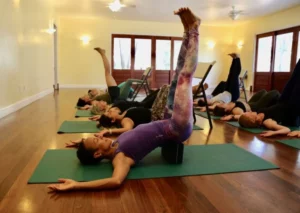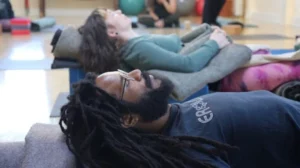Trauma-informed yoga teaching is a practice that recognizes the potential for yoga to trigger past traumatic experiences. Additionally, it takes steps to create a safe, supportive environment for students. This approach to teaching yoga acknowledges the prevalence of trauma and its potential impact on an individual’s physical and emotional well-being. Recognizing the signs of trauma and taking steps to support students in this way, honors their unique experiences. Also, yoga teachers can create a space where students can feel safe, supported, and empowered to heal.
The practice of trauma-informed yoga has been shown to have a number of physical and mental health benefits. These include reducing stress and anxiety, improving flexibility and strength, and promoting relaxation (NIH, n.d.). However, for some individuals, the practice of yoga can also be triggering, particularly for those who have experienced past trauma (Hicks & Kaminoff, 2017).

Trauma-Informed Yoga Teaching
To be trauma-informed, a yoga teacher must be aware of the potential for trauma to be triggered. They must also take steps to create a safe and supportive environment for students (Kaminoff, 2018). This includes creating clear boundaries, respecting students’ personal space, and creating an atmosphere of safety and support (Hicks & Kaminoff, 2017). Trauma-informed yoga classes are designed to help students regulate their nervous system and bring them back into their window of tolerance. Teachers are trained to adapt the yoga postures and movements carefully to down-regulate the nervous system and promote relaxation, mindfulness, and self-awareness. In addition, the instructors are trained to use language that is non-judgmental, non-coercive, and emphasizes choice and empowerment.

Trauma-Informed Yoga Environment
One way to create a safe and supportive environment for trauma-informed yoga is to offer options for students to modify or opt out of certain poses or practices. For example, if a pose involves being upside down, a teacher can offer alternatives for students who may feel uncomfortable in that position. Additionally, teachers can provide verbal and physical cues to students, rather than physically adjusting them into a pose (Kaminoff, 2018).
Trauma-Informed Yoga Languaging
It is also important for teachers to be mindful of the language they use in trauma-informed yoga classes. This is because certain words or phrases may be triggering for some students (Hicks & Kaminoff, 2017). For example, words like “fight”, “warrior” and even “corpse pose” may be triggering for individuals such as veterans who have seen combat. Teachers can use language that is more inclusive and neutral. Such as “move with intention” or “find your strength” or “come into resting pose” (Kaminoff, 2018).

Psycho-education
In addition to creating a safe and supportive trauma-informed yoga environment, it is important for teachers to be aware of the signs of trauma and be prepared to offer support to students who may be experiencing triggers. Some signs to look for include difficulty regulating emotions, difficulty with physical sensations, and disassociation or detachment (Hicks & Kaminoff, 2017). If a student exhibits these signs, a teacher can offer support by providing a calming presence, a safe space to rest, or resources for additional support (Kaminoff, 2018).
It is also important for teachers to recognize their own limitations and seek additional training or support as needed. Since trauma can be a complex and sensitive topic, and it is important for trauma-informed yoga teachers to be aware of their own biases and limitations, and to seek out additional training or support as needed (Hicks & Kaminoff, 2017).
In Conclusion
Finally, trauma-informed yoga teaching is an approach to teaching yoga that recognizes the potential for yoga to trigger past traumatic experiences and takes steps to create a safe, supportive environment for students. By being aware of the signs of trauma, offering options for students to modify or opt out of certain poses or practices, and being mindful of language and boundaries, teachers can create a space where students can feel safe, supported, and empowered to heal. While trauma can be a complex and sensitive topic, with the right resources, yoga teachers knowledgeable in trauma-informed yoga can play a valuable role in supporting students on their journey toward healing and recovery.
Lastly, want to learn more about this topic?
Consider studying with Alison Scola, A C-IAYT Trauma-Informed Yoga Therapist

Understanding Trauma & Resilience. Building Skills for Yoga Teachers
Or Check out our LIVE PROGRAMS
References:
Hicks, S., & Kaminoff, L. (2017). Yoga for trauma: A guide to restoring the self. North Atlantic Books.
Kaminoff, L. (2018). Yoga anatomy (2nd ed.). Human Kinetics.
NIH (n.d.). Yoga for health. National Center for Complementary and Integrative Health. Retrieved from https://www.nccih.nih.gov/health/yoga-for-health
WHO (n.d.). Mental health and psychosocial support. World Health Organization. Retrieved from https://www.who.int/mental_health/prevention/suicide/suicideprevent/en/